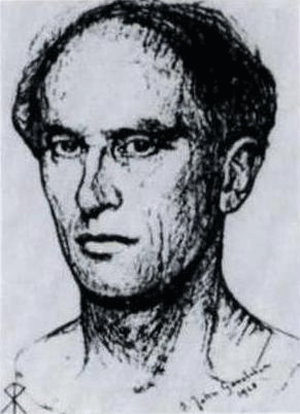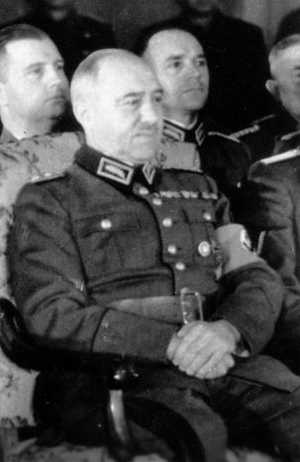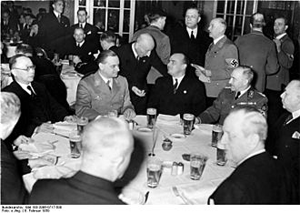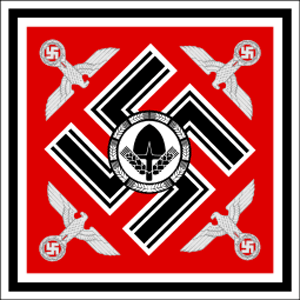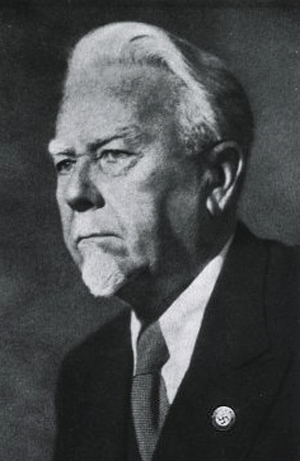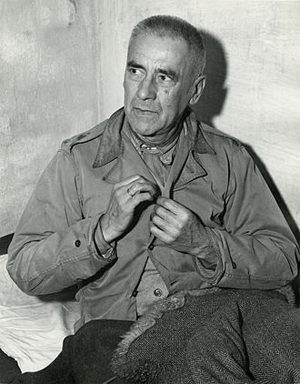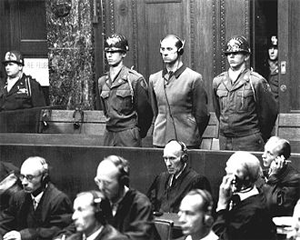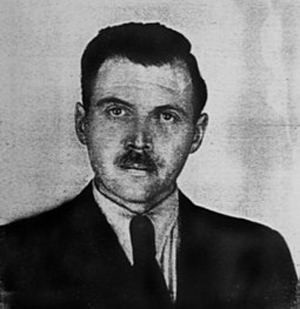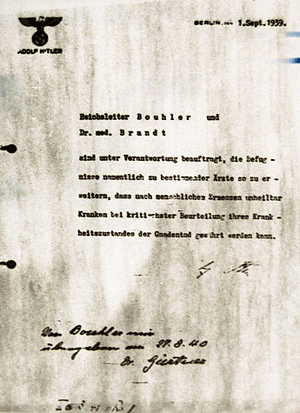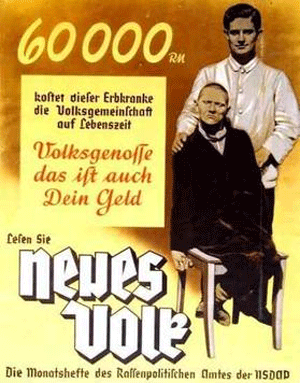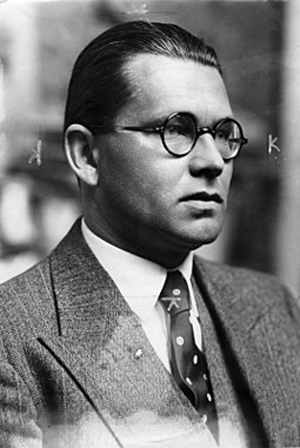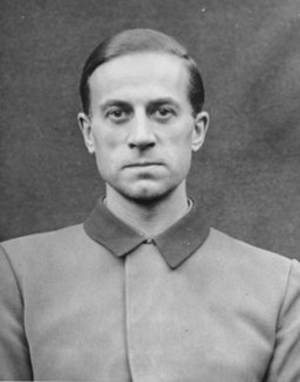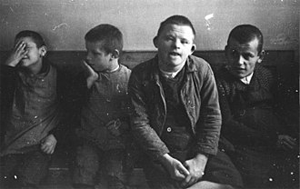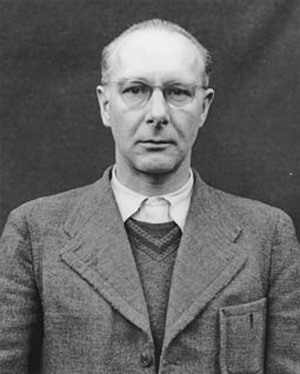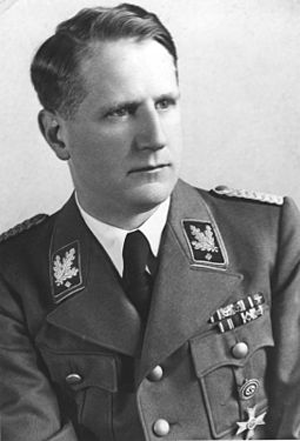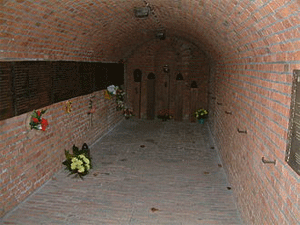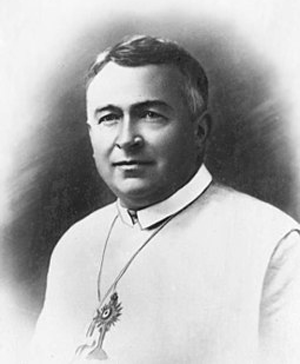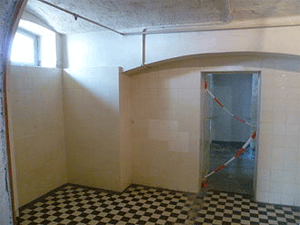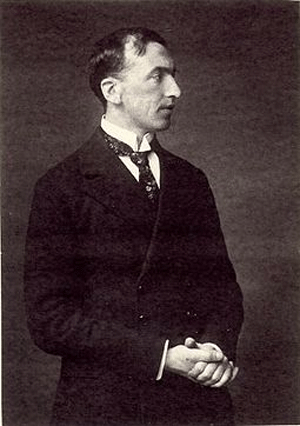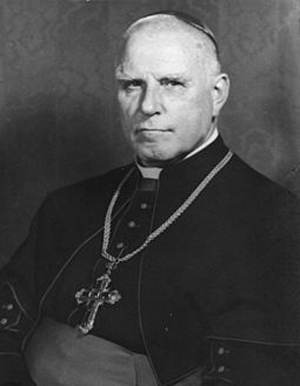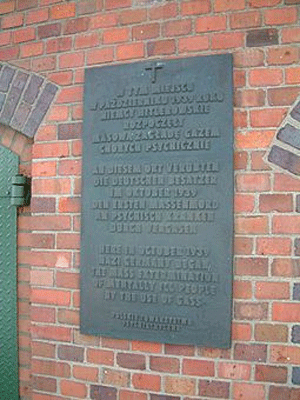Part 2 of 2
Suspension of T4 killingsOn 24 August 1941, Hitler ordered the suspension of the T4 killings. After the invasion of the Soviet Union in June, many T4 personnel were transferred to the east to begin work on the final solution to the Jewish question. The projected death total for the T4 program of 70,000 deaths had been reached by August 1941.[121] The termination of the T4 programme did not end the killing of people with disabilities; from the end of 1941, the killing of adults and children continued less systematically to the end of the war on the local initiative of institute directors and party leaders. After the bombing of Hamburg in July 1943, occupants of old age homes were killed. In the post-war trial of Dr. Hilda Wernicke, Berlin, August, 1946, testimony was given that "500 old, broken women" who had survived the bombing of Stettin in June 1944 were euthanized at the Meseritz-Oberwalde Asylum.[122] The Hartheim, Bernberg, Sonnenstein and Hardamar centres continued in use as "wild euthanasia" centres to kill people sent from all over Germany, until 1945.[121] The methods were lethal injection or starvation, those employed before use of gas chambers.[123] By the end of 1941, about 100,000 people had been killed in the T4 programme.[124] From mid-1941, concentration camp prisoners too feeble or too much trouble to keep alive were murdered after a cursory psychiatric examination under Action 14f13.[125]
Post-war
Doctors' trialAfter the war a series of trials was held in connection with the Nazi euthanasia programme at various places including: Dresden, Frankfurt, Graz, Nuremberg and Tübingen. In December 1946 an American military tribunal (commonly called the Doctors' trial) prosecuted 23 doctors and administrators for their roles in war crimes and crimes against humanity. These crimes included the systematic killing of those deemed "unworthy of life", including people with mental disabilities, the people who were institutionalized mentally ill, and people with physical impairments. After 140 days of proceedings, including the testimony of 85 witnesses and the submission of 1,500 documents, in August 1947 the court pronounced 16 of the defendants guilty. Seven were sentenced to death and executed on 2 June 1948, including Brandt and Brack.
The indictment read in part:
14. Between September 1939 and April 1945 the defendants Karl Brandt, Blome, Brack, and Hoven unlawfully, wilfully, and knowingly committed crimes against humanity, as defined by Article II of Control Council Law No. 10, in that they were principals in, accessories to, ordered, abetted, took a consenting part in, and were connected with plans and enterprises involving the execution of the so called "euthanasia" program of the German Reich, in the course of which the defendants herein murdered hundreds of thousands of human beings, including German civilians, as well as civilians of other nations. The particulars concerning such murders are set forth in paragraph 9 of count two of this indictment and are incorporated herein by reference.
— International Military Tribunal[126]
Earlier, in 1945, American forces tried seven staff members of the Hadamar killing centre for the killing of Soviet and Polish nationals, which was within their jurisdiction under international law, as these were the citizens of wartime allies. (Hadamar was within the American Zone of Occupation in Germany. This was before the Allied resolution of December 1945, to prosecute individuals for "crimes against humanity" for such mass atrocities.) Alfons Klein, Karl Ruoff and Wilhelm Willig were sentenced to death and executed; the other four were given long prison sentences.[127] In 1946, newly reconstructed German courts tried members of the Hadamar staff for the murders of nearly 15,000 German citizens at the facility. Adolf Wahlmann and Irmgard Huber, the chief physician and the head nurse, were convicted.
Other perpetrators 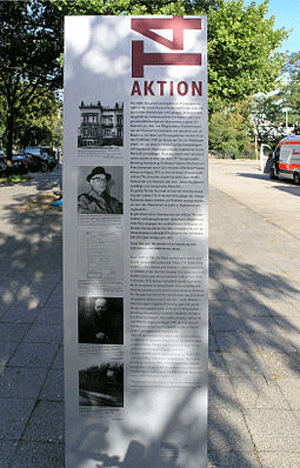 Aktion T4 marker (2009) in Berlin
Aktion T4 marker (2009) in Berlin• August Becker, initially sentenced to three years after the war, in 1960 was tried again and sentenced to ten years in prison. He was released early due to ill health and died in 1967.[128]
• Werner Blankenburg lived under an alias and died in 1957.[129]
• Philipp Bouhler committed suicide in captivity, May 1945.[129]
• Werner Catel was cleared by a denazification board after World War II and was head of pediatrics at the University of Kiel.[130] He retired early after his role in the T4 program was exposed but continued to support the killing of children with mental and physical disabilities.[131]
• Leonardo Conti hanged himself in captivity, 6 October 1945.[132]
• Dr. Ernst-Robert Grawitz killed himself shortly before the fall of Berlin in April 1945.[133]
• Dr. Herbert Linden committed suicide in 1945. Overseers of the program were initially Herbert Linden and Werner Heyde. Linden was later replaced by Hermann Paul Nitsche.[134]
• Dr. Fritz Cropp d. 6 April 1984, Bremen. A Nazi official in Oldenburg, Cropp was appointed the country medical officer of health in 1933. In 1935 he transferred to Berlin, where he worked as a ministerial adviser in the Division IV (health care and people care) in the Ministry of the Interior. In 1939, he became Assistant Director; Cropp was involved in the Nazi "euthanasia" Aktion T4 in 1940. He was Herbert Linden's superior and was responsible for patient transfers.[135]
• Dr. Werner Heyde[125] after escaping detection for 18 years, killed himself in 1964 before being brought to trial.
• Dr. Heinrich Gross was tried twice. One sentence was overturned and the charges in the second trial in 2000 were dropped as a result of his dementia; he died in 2005.[136]
• Lorenz Hackenholt vanished in 1945.[137]
• Erich Koch served time in prison from 1950 to his death in 1986.[138]
• Erwin Lambert died in 1976.[137]
• Dr. Friedrich Mennecke died in 1947 while awaiting trial.[139]
• Philipp, Landgrave of Hesse, the governor of Hesse-Nassau, was tried in 1947 at Hadamar for his role in Aktion T4 but was sentenced only to two years' "time served"; he died in 1980.[140]
 Aktion T4 memorial at Tiergartenstraße 4, Berlin
Aktion T4 memorial at Tiergartenstraße 4, Berlin• Paul Nitsche was tried and executed by an East German court in 1948.[141]
• Professor Carl Schneider hanged himself in his prison cell in 1946, while awaiting trial.[142]
• Franz Schwede was sentenced to 10 years in prison in 1948 and was released in 1956; he died in 1960.[143]
• Dr. Ernst Illing was the director of the Vienna Psychiatric-Neurological Clinic for Children Am Spielgrund, where he killed about 200 children; sentenced to death on 18 July 1946.[144]
• Dr. Marianne Türk was a doctor at Vienna Psychiatric-Neurological Clinic for Children Am Spielgrund where, with Ernst Illing, she killed 200 children. She was sentenced to 10 years prison on 18 July 1946.[144]
The Ministry for State Security of East Germany stored around 30,000 files of Aktion T4 in their archives. Those files became available to the public only after the German Reunification in 1990, leading to a new wave of research on these wartime crimes.[145]
MemorialsThe German national memorial to the people with disabilities murdered by the Nazis was dedicated in 2014 in Berlin.[146][147] It is located in the pavement of a site next to the Tiergarten park, the location of the former villa at Tiergartenstrasse 4 in Berlin, where more than 60 Nazi bureaucrats and doctors worked in secret under the "T4" program to organize the mass murder of sanatorium and psychiatric hospital patients deemed unworthy to live.[147]
See also• Nazi doctors (list)
• Nazi eugenics, the racially based social policies that placed the improvement of the Aryan race at the heart of Nazis ideology.
• Nazi medical experimentation
• Operation Reinhard, men of Aktion T4 provided expertise for building the extermination camps during the Holocaust.
• Aktion 14f13 (1941–44), a Nazi extermination operation that killed prisoners who were sick, elderly, or deemed no longer fit for work
• Racial hygiene
• T4-Gutachter experts selecting victims killed by gas in "euthanasia" centers
• Ich klage an, Nazi pro-euthanasia propaganda film
• Life unworthy of life
Killing centers• Am Spiegelgrund clinic
• Bernburg Euthanasia Centre
• Brandenburg Euthanasia Centre
• Grafeneck Euthanasia Centre
• Hadamar Euthanasia Centre
• Hartheim Euthanasia Centre
• Soldau concentration camp
• Sonnenstein Euthanasia Centre
• Jewish skeleton collection
• Nazi euthanasia and the Catholic Church
Notes1. As many as 100,000 people may have been killed directly as part of Action T-4. Mass euthanasia killings were also carried out in the Eastern European countries and territories Nazi Germany conquered during the war. Categories are fluid, and no definitive figure can be assigned but historians put the total number of victims at around 300,000.[3]
2. Sandner wrote that the term Aktion T4 was first used in post-war trials against doctors involved in the killings and later included in the historiography.[4]
3. Tiergartenstraße 4 was the location of the Central Office and administrative headquarters of the Gemeinnützige Stiftung für Heil- und Anstalts- pflege (Charitable Foundation for Curative and Institutional Care).[7]
4. Notes on patient records from the archive "R 179" of the Chancellery of the Führer Main Office II b. Between 1939 and 1945, about 200,000 women, men and children in psychiatric institutions of the German Reich were killed in covert actions by gas, medication or starvation. Original: Zwischen 1939 und 1945 wurden ca. 200.000 Frauen, Männer und Kinder aus psychiatrischen Einrichtungen des Deutschen Reichs im mehreren verdeckten Aktionen durch Vergasung, Medikamente oder unzureichende Ernährung ermordet.[13]
5. Robert Lifton and Michael Burleigh estimated that twice the official number of T4 victims may have perished before the end of the war.[21][page needed][19] Ryan and Schurman gave an estimated range of 200,000 and 250,000 victims of the policy upon the arrival of Allied troops in Germany.[22]
6. [24]
7. This was the result either of club foot or osteomyelitis. Goebbels is commonly said to have had club foot (talipes equinovarus), a congenital condition. William L. Shirer, who worked in Berlin as a journalist in the 1930s and was acquainted with Goebbels, wrote in The Rise and Fall of the Third Reich (1960) that the deformity was from a childhood attack of osteomyelitis and a failed operation to correct it.[34]
8. Robert Lifton wrote that this request was "encouraged"; the severely disabled child and the agreement of the parents to his killing were apparently genuine.[40]
9. Professors Werner Catel (a Leipzig psychiatrist) and Hans Heinze, head of a state institution for children with intellectual disabilities at Görden near Brandenburg; Ernst Wentzler a Berlin pediatric psychiatrist and the author Dr. Helmut Unger.[61]
10. Lifton concurs with this figure, but notes that the killing of children continued after the T4 programme was formally ended in 1941.[66]
11. The second phase of Operation Tannenberg referred to as the Unternehmen Tannenberg by Heydrich's Sonderreferat began in late 1939 under the codename Intelligenzaktion and lasted until January 1940, in which 36,000–42,000 people, including Polish children, died before the end of 1939 in Pomerania.[70]
12. Several drafts of a formal euthanasia law were prepared but Hitler refused to authorise them. The senior participants in the programme always knew that it was not a law, even by the loose definition of legality prevailing in Nazi Germany.[75]
13. According to Lifton, most Jewish inmates of German mental institutions were dispatched to Lublin in Poland in 1940 and killed there.[82]
14. These figures come from the article Aktion T4 on the German Wikipedia, which sources them to Ernst Klee.[89]
15. Role of T4 "Inspector" Christian Wirth in the Holocaust.[98]
Footnotes1. "Exhibition catalogue in German and English" (PDF). Berlin, Germany: Memorial for the Victims of National Socialist ›Euthanasia‹ Killings. 2018.
2. "Euthanasia Program" (PDF). Yad Vashem. 2018.
3. Chase, Jefferson (26 January 2017). "Remembering the 'forgotten victims' of Nazi 'euthanasia' murders". Deutsche Welle.
4. Sandner 1999, p. 385.
5. Hojan & Munro 2015.
6. Bialas & Fritze 2014, pp. 263, 281.
7. Sereny 1983, p. 48.
8. Proctor 1988, p. 177.
9. Longerich 2010, p. 477.
10. Browning 2005, p. 193.
11. Proctor 1988, p. 191.
12. German Federal Archive (2013). "Euthanasia in the Third Reich"[Euthanasie im Dritten Reich]. Bundesarchiv. German Federal Archive.
13. German Federal Archive (2013). "Euthanasia in the Third Reich"[Euthanasie im Dritten Reich]. Bundesarchiv. German Federal Archive.
14. Evans 2009, p. 107.
15. Burleigh 2008, p. 262.
16. Evans 2009, p. 98.
17. Burleigh & Wippermann 2014.
18. Adams 1990, pp. 40, 84, 191.
19. Lifton 1986, p. 142.
20. Ryan & Schuchman 2002, pp. 25, 62.
21. Burleigh 1995.
22. Ryan & Schuchman 2002, p. 62.
23. Lifton 2000, p. 102.
24. "Sources on the History of the "Euthanasia" crimes 1939–1945 in German and Austrian Archives"[Quellen zur Geschichte der “Euthanasie”-Verbrechen 1939–1945 in deutschen und österreichischen Archiven] (PDF). Bundesarchiv. 2018.
25. Hansen & King 2013, p. 141.
26. Hitler, p. 447.
27. Padfield 1990, p. 260.
28. Evans 2005, pp. 507–508.
29. "Forced Sterilization". United States Holocaust Memorial Museum.
30. Engstrom, Weber & Burgmair 2006, p. 1710.
31. Joseph 2004, p. 160.
32. Bleuler 1924, p. 214.
33. Read 2004, p. 36.
34. Shirer 1960, p. 124.
35. Evans 2005, p. 508.
36. Miller 2006, p. 160.
37. Breggin 1993, pp. 133–148.
38. Kershaw 2000, p. 256.
39. Friedman 2011, p. 146.
40. Lifton 1986, p. 50.
41. Schmidt 2007, p. 118.
42. Cina & Perper 2012, p. 59.
43. Lifton 1986, pp. 50–51.
44. Proctor 1988, p. 10.
45. Browning 2005, p. 190.
46. Lifton 1986, p. 62.
47. Baader 2009, pp. 18–27.
48. Lifton 1986, pp. 62–63.
49. Schmitt 1965, pp. 34–35.
50. Lifton 1986, p. 47.
51. Kershaw 2000, p. 254.
52. Evans 2005, p. 444.
53. Lifton 1986, pp. 48–49.
54. Browning 2005, p. 185.
55. Kershaw 2000, p. 259.
56. Miller 2006, p. 158.
57. Torrey & Yolken 2010, pp. 26–32.
58. Local 2014.
59. Kaelber 2015.
60. Weindling 2006, p. 6.
61. Lifton 1986, p. 52.
62. Sereny 1983, p. 55.
63. Lifton 1986, p. 60.
64. "The war against the "inferior". On the History of Nazi Medicine in Vienna - Chronology". A project by the Documentation Center of Austrian Resistance.
65. Lifton 1986, p. 56.
66. Lifton 1986, p. 55.
67. Friedlander 1995, p. 163.
68. Evans 2004, p. 93.
69. Semków 2006, pp. 46–48.
70. Semków 2006, pp. 42–50.
71. Friedlander 1995, p. 87.
72. Browning 2005, pp. 186–187.
73. Browning 2005, p. 188.
74. Kershaw 2000, p. 261.
75. Lifton 1986, pp. 63–64.
76. Padfield 1990, p. 261.
77. Kershaw 2000, p. 253.
78. Lifton 1986, p. 64.
79. Lifton 1986, pp. 66–67.
80. Browning 2005, p. 191.
81. Padfield 1990, pp. 261, 303.
82. b Lifton 1986, p. 77.
83. Lifton 1986, p. 67.
84. Annas & Grodin 1992, p. 25.
85. Lifton 1986, pp. 71–72.
86. Burleigh 2000, p. 54.
87. Lifton 1986, p. 71.
88. Lifton 1986, p. 74.
89. Klee 1983.
90. Sereny 1983, pp. 41–90.
91. Hojan & Munro 2013.
92. "Euthanasie«-Morde". Foundation the Monument for the Murdered Jews of Europe. Retrieved 4 March 2018.
93. Klee 1985, p. 232.
94. Jaroszewski 1993.
95. WNSP State Hospital 2013.
96. Beer 2015, pp. 403–417.
97. Ringelblum 2013, p. 20.
98. Sereny 1983, p. 54.
99. Joniec 2016, pp. 1–39.
100. Sereny 1983, p. 71.
101. Lifton 1986, p. 75.
102. Sereny 1983, p. 58.
103. Lifton 1986, pp. 80, 82.
104. Lifton 1986, p. 90.
105. NEP 2017.
106. Lifton 1986, pp. 90–92.
107. Padfield 1990, p. 304.
108. Schmuhl 1987, p. 321.
109. Burleigh 2008, p. 261.
110. Ericksen 2012, p. 111.
111. Evans 2009, p. 110.
112. Lifton 1986, p. 93.
113. Lifton 1986, p. 94.
114. Kershaw 2000, pp. 427, 429.
115. Lifton 1986, p. 95.
116. Evans 2009, p. 112.
117. Burleigh 2008, p. 26.
118. Friedlander 1997, p. 111.
119. Griech-Polelle 2002, p. 76.
120. Evans 2009, pp. 529–530.
121. Burleigh 2008, p. 263.
122. Aly & Chroust 1994, p. 88.
123. Lifton 1986, pp. 96–102.
124. Hilberg 2003, p. 1,066.
125. Hilberg 2003, p. 932.
126. Taylor 1949.
127. NARA 1980, pp. 1–12.
128. "Trauriges Bild" [Sad Image]. Der Spiegel (in German). 50. 4 December 1967. Retrieved 22 August 2018.
129. Hilberg 2003, p. 1,175.
130. "Professor Werner Catel: Die Medizinische Fakultät" [Enmeshed in the Nazi Euthanasia Program: The Physician Werner Catel] (in German). University of Kiel. 14 November 2006. Retrieved 22 August 2018.
131. "Werner Catel (1894–1981)". Memorial and Information Point for the victims of the National Socialist »euthanasia« killings. 10 August 2017. Retrieved 24 August 2018.
132. Hilberg 2003, p. 1,176.
133. Hilberg 2003, p. 1,179.
134. Sandner, Peter (2003). Verwaltung des Krankenmordes [Administration of Suicides]. Historische Schriftenreihe Des Landeswohlfahrtsverbandes Hes (in German). 2. Gießen: Psychosozial. p. 395. ISBN 3-89806-320-8.
135. Hilberg 2003, p. 1,003.
136. Martens, D. (2004). "Unfit to live". Canadian Medical Association Journal. Canadian Medical Association. 171 (6): 619–620. doi:10.1503/cmaj.1041335.
137. Berenbaum & Peck 2002, p. 247.
138. Hilberg 2003, p. 1,182.
139. Chroust, Peter, ed. (1988). Friedrich Mennecke. Innenansichten eines medizinischen Täters im Nationalsozialismus. Eine Edition seiner Briefe 1935–1947 [Friedrich Mennecke. Interior Views of a Medical Offender in National Socialism: An Edition of his Letters 1935-1947]. Hamburger Instituts für Sozialforschung. p. 8f. ISBN 3-926736-01-1.
140. Petropoulos, Jonathan (2009). Royals and the Reich: The Princes von Hessen in Nazi Germany. Oxford: Oxford University Press. p. 67. ISBN 0199212783.
141. Böhm, B. (2012). "Paul Nitsche – Reformpsychiater und Hauptakteur der NS-"Euthanasie"". Der Nervenarzt. Springer-Verlag. 83 (3): 293–302. doi:10.1007/s00115-011-3389-1.
142. L Singer (3 December 1998). "Ideology and ethics. The perversion of German psychiatrists' ethics by the ideology of national socialism". European Psychiatry. Elsevier SAS. 13(Supplement 3): 87, 92. doi:10.1016/S0924-9338(98)80038-2. PMID 19698678. Carl Schneider committed suicide by hanging after his arrest...(subscription required)
143. Nöth, Stefan (1 May 2004). "Antisemitismus". Voraus zur Unzeit. Coburg und der Aufstieg des Nationalsozialismus in Deutschland (in German). Initiative Stadtmuseum Coburg. p. 82. ISBN 9783980800631.
144. Totten & Parsons 2009, p. 181.
145. Buttlar 2003.
146. ABC News. "International News - World News - ABC News". ABC News.
147. "Berlin Dedicates Holocaust Memorial for Disabled - Global Agenda - News - Arutz Sheva". Arutz Sheva.
References
Books• Adams, Mark B. (1990). The Wellborn Science: Eugenics in Germany, France, Brazil and Russia. Monographs on the History and Philosophy of Biology. New York: Oxford University Press. ISBN 978-0-19-505361-6.
• Aly, Gotz; Chroust, Peter (1994). Cleansing the Fatherland [Contributions to National Socialist Health and Social Policy]. Trans. Journal: Beiträge zur Nationalsozialistischen Gesundheits- und Sozial- politik. Baltimore, MD: Johns Hopkins University Press. ISBN 978-0-8018-4775-2.
• Annas, George J.; Grodin, Michael A. (1992). The Nazi Doctors and the Nuremberg Code: Human Rights in Human Experimentation. Oxford University Press. ISBN 978-0-19-977226-1.
• Berenbaum, Michael; Peck, Abraham J. (2002). The Holocaust and History: The Known, the Unknown, the Disputed and the Re-examined. Bloomington, IN: Indiana University Press. ISBN 978-0-253-21529-1.
• Bialas, Wolfgang; Fritze, Lothar (2015). Nazi Ideology and Ethics. Newcastle: Cambridge Scholars. ISBN 978-1-4438-5881-6.
• Bleuler, E. (1924). Textbook of Psychiatry [Lehrbuch der Psychiatrie]. trans. A. A. Brill. New York: Macmillan. OCLC 3755976.
• Browning, Christopher (2005). The Origins of the Final Solution: The Evolution of Nazi Jewish Policy, September 1939 – March 1942. Arrow. ISBN 978-0-8032-5979-9.
• Burleigh, Michael (1995). Death and Deliverance: 'Euthanasia' in Germany 1900–1945. New York: Verlag Klemm & Oelschläger. ISBN 978-0-521-47769-7.
• Burleigh, Michael (2000). "Psychiatry, German Society and the Nazi "Euthanasia" Programme". In Bartov, Omer. The Holocaust Origins, Implementation, Aftermath. London: Routledge. ISBN 978-0-415-15036-1.
• Cina, Stephen J.; Perper, Joshua A. (2010). When Doctors Kill: Who, Why, and How (online ed.). New York: Copernicus Books. ISBN 978-1-4419-1369-2.
• Ericksen, Robert P. (2012). Complicity in the Holocaust: Churches and Universities in Nazi Germany (online ed.). Cambridge: Cambridge University Press. doi:10.1017/CBO9781139059602. ISBN 978-1-280-87907-4.
• Evans, Suzanne E. (2004). Forgotten Crimes: The Holocaust and People with Disabilities. Chicago, IL: Ivan R. Dee. ISBN 978-1-56663-565-3.
• Evans, Richard J. (2005). The Third Reich in Power. London: Allen Lane. ISBN 978-0-7139-9649-4.
• Evans, Richard J. (2009). The Third Reich at War. New York City: Penguin. ISBN 978-1-59420-206-3.
• Friedlander, Henry (1995). The Origins of Nazi Genocide: From Euthanasia to the Final Solution. Chapel Hill, NC: University of North Carolina Press. ISBN 978-0-8078-2208-1.
• Friedlander, Henry (1 September 1997). The Origins of Nazi Genocide: From Euthanasia to the Final Solution. Chapel Hill, NC: University of North Carolina Press. ISBN 978-0-8078-4675-9.
• Friedman, Jonathan C. (2011). The Routledge History of the Holocaust. London: Routledge. ISBN 978-0-203-83744-3.
• Griech-Polelle, Beth A. (2002). Bishop von Galen: German Catholicism and National Socialism. New Haven, CT: Yale University Press. ISBN 978-0-300-13197-0.
• Hansen, Randall; King, Desmond S. (2013). Sterilized by the State: Eugenics, Race and the Population Scare in Twentieth-Century North America (Cambridge Books Online ed.). New York: Cambridge University Press. doi:10.1017/CBO9781139507554. ISBN 978-1-139-50755-4.
• Hilberg, R. (2003). The Destruction of the European Jews. III (3rd ed.). New Haven, CT: Yale University Press. ISBN 978-0-300-09557-9.
• Hitler, A. Mein Kampf [My Struggle] (in German).
• Joniec, Jarosław (2016). Historia Niemieckiego Obozu Zagłady w Bełżcu [History of the Belzec Extermination Camp] (in Polish). Lublin: Muzeum - Miejsce Pamięci w Bełżcu (National Bełżec Museum & Monument of Martyrology). ISBN 978-83-62816-27-9.
• Joseph, Jay (2004). The Gene Illusion: Genetic Research in Psychiatry and Psychology under the Microscope. New York: Algora Publishing. ISBN 978-0-87586-344-3.
• Kershaw, Ian (2000). Hitler: 1936–1945 Nemesis. II. New York: Norton. ISBN 978-0-393-32252-1.
• Klee, Ernst (1983). Euthanasie im NS-Staat. Die Vernichtung lebensunwerten Lebens [Euthanasia in the NS State: The Destruction of Life Unworthy of Life] (in German). Frankfurt am Main: Fischer Taschenbuch Verlag. ISBN 978-3-596-24326-6.
• Klee, Ernst (1985). Dokumente zur Euthanasie [Documents on Euthanasia] (in German). Frankfurt am Main: Fischer Taschenbuch Verlag. ISBN 978-3-596-24327-3.
• Lifton, R. J. (1986). The Nazi Doctors: Medical Killing and the Psychology of Genocide. New York: Basic Books. ISBN 978-0-465-04904-2. Archived from the original on 3 September 2006.
• Lifton, R. J. (2000). The Nazi Doctors: Medical Killing and the Psychology of Genocide. New York: Basic Books. ISBN 978-0-465-04905-9.
• Longerich, P. (2010). Holocaust: The Nazi Persecution and Murder of the Jews. Oxford: Oxford University Press. ISBN 978-0-19-280436-5.
• Miller, Michael (2006). Leaders of the SS and German Police. I. San Jose, CA: R. James Bender. ISBN 978-93-297-0037-2.
• Padfield, Peter (1990). Himmler: Reichsführer-SS. London: Macmillan. ISBN 978-0-333-40437-9.
• Proctor, Robert N. (1988). Racial Hygiene: Medicine under the Nazis. Cambridge, MA: Harvard College. ISBN 978-0-674-74578-0.
• Read, J. (2004). "Genetics, Eugenics and Mass Murder". In Read, J.; Mosher, R. L.; Bentall, R. P. Models of Madness: Psychological, Social and Biological Approaches to Schizophrenia. ISPD book. Hove, East Sussex: Brunner-Routledge. ISBN 978-1-58391-905-7.
• Ringelblum Archives of the Holocaust: Introduction (PDF). Warsaw: Wydawnictwa Uniwersytetu Warszawskiego. 2013. Retrieved 12 March2017.
• Ryan, Donna F.; Schuchman, John S. (2002). Racial Hygiene: Deaf People in Hitler's Europe. Patricia Heberer, "Targetting the Unfit". Washington, D.C.: Gallaudet University Press. ISBN 978-1-56368-132-5.
• Schmidt, Ulf (2007). Karl Brandt: The Nazi Doctor. London: Hambledon Continuum. ISBN 978-1-84725-031-5.
• Schmitt, Gerhard (1965). Selektion in der Heilanstalt 1939–1945 [Selection in the Sanatorium 1939–1945]. Stuttgart: Evangelisches Verlagsanstalt. OCLC 923376286.
• Schmuhl, Hans-Walter (1987). Rassenhygiene, Nationalsozialismus, Euthanasie: Von der Verhütung zur Vernichtung "lebensunwerten Lebens", 1890–1945 [Racial Hygiene, National Socialism, Euthanasia: From Prevention to Destruction of Life Unworthy of Life 1890–1945]. Kritische Studien zur Geschichtswissenschaft (in German). 75. simultaneous PhD University of Bielefeld, Bielefeld 1986 as Die Synthese von Arzt und Henker. Göttingen: Vandenhoeck & Ruprecht. ISBN 978-3-525-35737-8.
• Sereny, Gitta (1983). Into that Darkness: An Examination of Conscience. New York, NY: Vintage Books. ISBN 978-0-394-71035-8.
• Shirer, William L. (1960). The Rise and Fall of the Third Reich. New York: Simon and Schuster. ISBN 978-0-449-21977-5.
• Taylor, T. (1949). Trials of War Criminals before the Nuernberg Military Tribunals: Under Control Council Law no. 10, Nuernberg, October 1946 – April 1949 (transcription) (United States Holocaust Museum ed.). Washington, DC: U.S. Government Printing Office. OCLC 504102502. Archived from the original on 4 May 2006.
• Totten, Samuel; Parsons, William S. (2009). Century of Genocide: Critical Essays and Eyewitness Accounts (3rd ed.). New York: Routledge. ISBN 978-0-415-99084-4.
• Weindling, Paul Julian (2006). Nazi Medicine and the Nuremberg Trials: From Medical War Crimes to Informed Consent. Basingstoke: Palgrave Macmillan. ISBN 978-0-230-50700-5.
Conferences• Baader, Gerhard (2009). Psychiatrie im Nationalsozialismus zwischen ökonomischer Rationalität und Patientenmord [Psychiatry in National Socialism: Between Economic Rationality and Patient Murder] (PDF). Geschichte der Psychiatrie: Nationalsocialismus und Holocaust Gedächtnis und Gegenwart (PDF). geschichtederpsychiatrie.at. Retrieved 12 March 2017.
Journals
• Breggin, Peter (1993). "Psychiatry's Role in the Holocaust" (PDF). International Journal of Risk & Safety in Medicine. 4 (2). doi:10.3233/JRS-1993-4204. PMID 23511221 – via PDF file direct download, 4.07 MB.
• Burleigh, Michael (2008). "Between Enthusiasm, Compliance and Protest: The Churches, Eugenics and the Nazi 'Euthanasia' Programme". Contemporary European History. 3 (03): 253–264. doi:10.1017/S0960777300000886. ISSN 0960-7773.
• Engstrom, E. J.; Weber, M. M.; Burgmair, W. (October 2006). "Emil Wilhelm Magnus Georg Kraepelin (1856–1926)". The American Journal of Psychiatry. British Library Serials. 163 (10). doi:10.1176/appi.ajp.163.10.1710. ISSN 0002-953X. PMID 17012678.
• Sandner, Peter (July 1999). "Die "Euthanasie"-Akten im Bundesarchiv. Zur Geschichte eines lange verschollenen Bestandes" [The 'Euthanasia' Files in the Federal Archives. On the History of a Long Lost Existence] (PDF). Vierteljahrschefte für Zeitgeschichte – Institut für Zeitgeschichte. Munich. 47 (3): 385–400. ISSN 0042-5702.
• Semków, Piotr (September 2006). "Kolebka" [Cradle] (PDF). IPN Bulletin. Warsaw: Institute of National Remembrance (IPN Gdańsk) (8–9 (67–68)). 42–50 44–51/152. ISSN 1641-9561. Retrieved 8 November 2015 – via direct download: 3.44 MB.
• Fuller Torrey, Edwin; Yolken, Robert (January 2010). "Psychiatric Genocide: Nazi Attempts to Eradicate Schizophrenia". Schizophrenia Bulletin. Oxford University Press (The Maryland Psychiatric Research Center and Schizophrenia International Research Society). 36 (1): 26–32. doi:10.1093/schbul/sbp097. ISSN 0586-7614. PMC 2800142. PMID 19759092.
Newspapers• Buttlar, H. (1 October 2003). "Nazi-"Euthanasie" Forscher öffnen Inventar des Schreckens" [Nazi 'Euthanasia' Researchers open Inventory of Horror]. Der Spiegel (online ed.). Hamburg. ISSN 0038-7452. Retrieved 12 March 2017.
• "Nazis Killed Hundreds at Austrian Mental Hospital". The Local AB. no oclc. 25 November 2014. Retrieved 16 February 2017.
Websites• Beer, Mathias (2015). "Die Entwicklung der Gaswagen beim Mord an den Juden" [The Development of the Gas-Van in the Murdering of the Jews]. The Final Solution. Vierteljahrshefte für Zeitgeschichte. Munich: Jewish Virtual Library. pp. 403–417. ISSN 0042-5702. Retrieved 12 March 2017.
• Burleigh, Michael; Wippermann, Wolfang (2014). "Nazi Racial Science". Washington, D.C.: United States Holocaust Memorial Museum. Retrieved 12 March 2017.
• Hojan, Artur; Munro, Cameron (2015). "Overview of Nazi 'Euthanasia' Programme". The Central Office at Tiergartenstrasse 4 in Berlin. The Tiergartenstrasse 4 Association. Further information: Kaminsky, Uwe (2014), "Mercy Killing and Economism" [in:] Bialas, Wolfgang; Fritze, Lothar (ed.), Nazi Ideology and Ethics. pp. 263–265. Cambridge Scholars Publishing, ISBN 1-4438-5422-0 OCLC 875635606. "Once emptied, the Polish institutions were almost exclusively turned over to the SS"[p. 265]. Retrieved 18 November 2017.
• Hojan, Artur; Munro, Cameron (28 February 2013). "Nazi Euthanasia Programme in Occupied Poland 1939–1945". Berlin, Kleisthaus: Tiergartenstrasse 4.
• Jaroszewski, Zdzisław (1993). "German extermination of psychiatric patients in Poland 1939-1945". Zaglada psychicznie chorych w Polsce 1939–1945 by Zdzisław Jaroszewski, ed., [Extermination of psychiatric hospital' patients in Poland 1939–1945]. PWN, Warsaw. Project InPosterum 2011. OCLC 68651789.
• Wiadomości (6 December 2013). "Hospital director and 1,350 patients killed including children. Commemoration of murder victims" [Zabili dyrektora szpitala psychiatrycznego w Świeciu oraz około 1350 pacjentów, także dzieci. Miasto upamiętni ten mord]. Gazeta Pomorska. Archived from the original on 17 November 2017.
• WNSP Świecie (2013). "History of Świecie Hospital" [Historia szpitala w Świeciu]. Regional State Hospital: Wojewódzki Szpital dla Nerwowo i Psychicznie Chorych, Samorząd Województwa Kujawsko-Pomorskiego. Archived from the original on 17 November 2017.
• "Psychiatrzy w obronie pacjentów". Niedziela, Tygodnik Katolicki. 4 February 2013. Archived from the original on 17 November 2017.
• Kaelber, Lutz (29 August 2015). "Am Spiegelgrund". University of Vermont. Retrieved 12 March 2017.
• "Quellen zur Geschichte der "Euthanasie"-Verbrechen 1939–1945 in deutschen und österreichischen Archiven" [Sources on the History of the 'Euthanasia' Crime 1939–1945 in German and Austrian Archives] (PDF) (in German). Berlin: Bundesarchiv. Retrieved 3 March 2018.
• "The Memorial Page of Nazi Euthanasia Programs". Germany National Memorial. Retrieved 12 March 2017.
• "United States of America v. Alfons Klein et al" (PDF). Captured German Records. National Archives and Records Administration. 1980. 12-449, 000-12-31. Retrieved 12 March 2017.
Further reading
Books• Bachrach, Susan D; Kuntz, Dieter (2004). Deadly Medicine: Creating the Master Race. United States Holocaust Memorial Museum Washington D.C.: University of North Carolina Press, Chapel Hill, NC. ISBN 978-0-8078-2916-5.
• Benzenhöfer, Udo (2010). Euthanasia in Germany Before and During the Third Reich. Münster/Ulm: Verlag Klemm & Oelschläger. ISBN 978-3-86281-001-7.
• Binding, K.; Hoche, A. (1920). Die Freigabe der Vernichtung lebensunwerten Lebens: Ihr Mass u. ihre Form [The Release of the Destruction of Life Unworthy of Life: Their Mass and Shape]. Leipzig: Meiner. OCLC 72022317.
• Burleigh, M.; Wippermann, W. (1991). The Racial State: Germany 1933–1945. Cambridge: Cambridge University Press. ISBN 978-0-521-39114-6.
• Burleigh, M. (1997). Ethics and Extermination: Reflections on Nazi Genocide. Part II. Cambridge: Cambridge University Press. pp. 113–152. ISBN 978-0-521-58211-7.
• Burleigh, M. (2001) [2000]. "Medicalized Mass Murder". The Third Reich: A New History (pbk. Pan ed.). London: Macmillan. pp. 382–404. ISBN 978-0-330-48757-3.
• Friedlander, Henry (1995). The Origins of Nazi Genocide. From Euthanasia to the Final Solution. Chapel Hill: University of North Carolina Press. ISBN 978-0-8078-2208-1.
• Klee, Ernst (1986). Was sie taten. Was sie wurden: Ärzte, Juristen und andere Beteiligte am Kranken- oder Judenmord [What They Did. What They Became: Doctors, Lawyers and other Partners in the Murder of the Ill and Jews] (in German). Frankfurt am Main: Fischer Taschenbuch. ISBN 978-3-596-24364-8.
• Klee, Ernst; Cropp, Fritz (2005). Das Personenlexikon zum Dritten Reich. Wer war was vor und nach 1945. Fischer Taschenbücher. Frankfurt am Main: Fischer-Taschenbuch-Verlag. ISBN 978-3-596-16048-8.
• Ley, Astrid; Hinz-Wessels, Annette (eds.). The "Euthanasia Institution" of Brandenburg an der Havel: Murder of the Ill and Handicapped during National Socialism. Schriftenreihe der Stiftung Brandenburgische Gedenkstätten. 35. Berlin: Metropol. ISBN 978-3-86331-086-8.
• Werthman, Fredric (1967). A Sign for Cain. New York: Macmillan. ISBN 978-0-02-625970-5.
Journals• Ost, Suzanne (April 2006). "Doctors and Nurses of Death: A Case Study of Eugenically Motivated Killing under the Nazi 'Euthanasia' Programme". The Liverpool Law Review. 27 (1): 5–30. doi:10.1007/s10991-005-5345-2. ISSN 0144-932X. PMID 17340766.
Websites• Webb, Chris (2009). "Otwock & the Zofiowka Sanatorium: A Refuge from Hell". Holocaust Research Project. Holocaust Education & Archive Research Team. Archived from the original on 11 July 2011 – via Internet Archive.
External links• Website with photo of Philipp Bouhler and facsimile of Hitler's letter to Bouhler and Brandt authorising the T4 programme
• United States Holocaust Memorial Museum Final Solutions: Murderous Racial Hygiene 1939–1945
• United States Holocaust Memorial Museum Euthanasia programme
• Nazis euthanasia files made public by the BMJ/British Medical Association: files relating to the 200,000 euthanasia crimes
